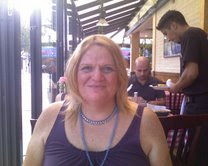As a teenager, I looked forward to Bicycling! magazine every month. Aside from learning about bikes and equipment I wouldn't encounter and couldn't afford, I learned that people did all sorts of things on, and with, their bicycles that I never imagined. In fact, I think the people who did those things didn't imagine them, either, until they undertook them.
One such person was John Rakowski, who rode his bicycle around the world and wrote a series of articles (journal entries, really) for the magazine. As much as I admired him, I would soon learn that he wasn't the first to accomplish ht e feat: Thomas Stevens did it eight decades earlier. Seven years after he completed his journey, Annie Kopchovsky would make a similar voyage.
Well, sort of. I'll get to that soon. Ms. Kopchovsky was born in Latvia, but her family emigrated to Boston when she was a child. At 18, she married Max Kopchovsky, a peddler. Within four years they had three children.
Much of what comes after that is a matter of debate. Kopchovsky said that her ride was the result of a bet two wealthy Bostonian men made: One asserted that women could do whatever men could, and his friend took the bait. They agreed on a wager that a woman could ride around the world in 15 months(!) and earn $5000 along the way. Nobody is sure why she felt compelled to take up the challenge as she, up to that point, had never been on a bicycle. However, she, like many other young women of her time, were inspired by Susan B. Anthony's assertion that the bicycle had done more to emancipate women than anything else.
So, on 27 June 1894, she hopped her 42-pound Columbia women's bike (Well, it was lighter than my Schwinn Collegiate, I think!) dressed in the long skirt, corset and high collar of that time and waved goodbye to her husband and children as she set off down Beacon Street. From there, she rode to New York. Before she took off, the Londonderry Lithia Spring Water Company (rolls right off the tongue, doesn't it?) offered her $100. In return, she would display their placard on her bike and adopt the nom de velo Anne Londonderry.
From New York, she pedaled west, arriving in Chicago in just under three months after she left Boston. Along the way, she lost 20 pounds. In the Windy City, she realized that she would need to make some changes. First of all, she realizing her bike was too heavy, she switched to a Sterling men's model with one gear and no brakes. It weighed tipped the scales at half of the Columbia's weight. Second, she realized she would never be able to ride that bike in her attire. So, at first, she wore bloomers, and eventually changed to a men's riding suit.
She'd planned to ride west, but the impending winter made her change direction. She rode back to New York and set sail for Le Havre, France, where she arrived in early December. Her bike was impounded, her money was stolen and the French press declared her too muscular to be a woman, assigning her to the category of "neutered beings." Somehow she turned things around and, in spite of bad weather, made it from Paris to Marseilles in two weeks via bike and train.
In Marseilles, she boarded the steamship "Sydney" , Her itinerary included all sorts of exotic ports of call. To prove she'd been to those places, she got the signature of the United States Consul in each location.
She returned to the US in San Francisco on 23 March 1895. From there, she rode south to Los Angeles, then east through Arizona and New Mexico to El Paso. From there, she turned north and rode to Denver, then Cheyenne, where she hopped on a train that took her to Nebraska. She then hopped back on her bike to Chicago, arriving on 12 September. Then she took the train back to Boston, arriving on 24 September, 15 months after she left.
As you might expect, some accused her of traveling more with her bike than on it. Most people didn't seem to mind, though: She was a tireless self-promoter who, while in France and Asia, told tales of being a medical student, the neice of a US Congressman, a lawyer, an inventor of a new method of stenography and an orphan. Plus, she sold commemorative photographs, silk handkerchiefs, souvenir pins and autographs. Upon returning to the US, she told tales of hunting with German royalty in India and nearly being killed by "Asiatics" who thought she was an evil spirit. She even insisted that she was involved in the Sino-Japanese War of 1895. On the front lines, she'd fallen through a frozen river and ended up in a Japanese prison with a bullet would in her shoulder. Or so she said.
But, hey, if she biked even half as much as she told stories, she rode a lot. And her pedaling brought her family more money, through sponsorships, her own entrepreneurship and articles she wrote, than her husband's peddling ever could have provided!










